Ischemia-modified Albumin as a Marker of Coronary Ischemia in Acute Organophosphorus-poisoned Patients: a Case-Control Study in Mansoura University Poison Unit
Shimaa M Motawei1*,Osama A Shabka1, Huiemi Liu2 and Mohamed Marouf3
1Department of Forensic Medicine and Clinical Toxicology, Mansoura University, Egypt
2Professor of Statistics, National Chengchi University, Taiwan
3House Officer, Mansoura University Hospitals, Egypt
Submission:May 09, 2022; Published: June 20, 2022
*Corresponding author: Shimaa M Motawei, Department of Forensic Medicine and Clinical Toxicology, Mansoura University, Egypt
How to cite this article: Shimaa M M,Osama A S, Huiemi L, Mohamed M. Ischemia-modified Albumin as a Marker of Coronary Ischemia in Acute Organophosphorus-poisoned Patients: a Case-Control Study in Mansoura University Poison Unit. Open Acc J of Toxicol. 2022; 5(3):555663. DOI: 10.19080/OAJT.2022.05.555663.
Abstract
Acute organophosphorus pesticide poisoning (OPP) is a significant health problem throughout the world. The diagnosis of cardiac ischemia remains a challenge in the Emergency Medicine, especially that cardiac troponin protein (cTn) may not rise during a reversible myocardial ischemia. Ischemia. Mo modified albumin (IMA) is suggested as an early and a sensitive biochemical marker of ischemia. This work aimed to assess the role of IMA in detecting cardiac ischemia in cases of OPP. IMA & cTnI were measured in 74 healthy control subjects and 48OPP cases attending to the Poison Unit in the Mansoura University Emergency Hospital. Sixty-nine contributors were male with an age range (17-68 years) and 53 were females with an age range (21- 55 years). IMA & cTnI levels were repeated after 4 and 12 hours in the OPP patients, together with electrocardiogram (EGG) monitoring. It was found that IMA was earlier to rise in OPP cases suspected to have cardiac ischemia than cTnI and before changes appear in the ECG. There was a significantly higher IMA levels in those cases on presentation than the healthy control subjects (P=0.0001). IMA levels did not rise significantly after 4 & 12 hours of follow up (P= 0.01662), unlike cTnI that raised in suspected cardiac ischemia cases after 4 & 12 hours (P=0.0001). So, ischemia modified albumin (IMA) is a useful marker that can be used as an early indicator of cardiac ischemia in OPP cases. Serum cTnI and ECG can be used for further follow up of patients.
Keywords:Ischemia-modified albumin; Cardiac troponin I; Acute coronary ischemia; Organophosphorus poisoning
Abbreviations:BChE: Butyryl Cholinesterase Enzyme, cTnI: Cardiac Troponin I, ECG: 12-Lead Electrocardiogram, ED: Emergency Department, IMA: Ischemia Modified Albumin, MgCl: Magnesium Chloride, Ml: Myocardial Infarction, NaCl: Sodium Chloride, NM: Nanometer, oC; Degree Centigrade, OP: Organophosphorus, OPP: Organophosphorus Poisoning, pH: An Expression of Hydrogen Ion Concentration in A Solution, RPM: Round Per Minute, STEMI: Acute St-Elevation Myocardial Infarction, USA: United States of America
Background
The diagnosis of cardiac ischemia remains a challenge in contemporary Emergency Medicine. A blood-borne biomarker is an attractive alternative to cardiac imaging and stress testing and would be cheaper and faster. Several candidate biomarkers have been proposed for the detection of cardiac ischemia; however, only Ischemia modified albumin (IMA) has been released for clinical use. IMA can be combined with electrocardiographic findings and cardiac troponin measurements for the early exclusion of acute coronary syndrome [1]. Acute organophosphorus pesticide poisoning is a significant health problem throughout the world, with the increasing use of organophosphorus compounds in agriculture [2]. Potentially lethal cardiac complications can occur in patients with acute organophosphate poisoning (OPP) and may be overlooked, leading to high morbidity and mortality rates of the poisoning. Cardiac complications of OPP may occur in the first few hours after exposure and may be delayed for days after poisoning [3].
Cardiac troponin (cTn) is sensitive and specific for detection of myocardial damage but may not rise during a reversible myocardial ischemia. Ischemia modified albumin (IMA) has been shown to be an early and sensitive biochemical marker of ischemia [4]. Troponins are protein molecules that are part of cardiac and skeletal muscle. They are released into the circulation when myocardial necrosis occurs, as seen in myocardial infarction. Smooth muscle cells do not contain troponins. Misleading elevated troponin with non- cardiac causes may occur. Troponin T and Troponin C can increase in inflammatory muscle diseases, e.g., in polymyositis. So, Troponin I is the cardiac enzyme variant that is more used to assess for cardiac muscle damage [5]. The cTnI test is highly specific and can be detected in 96.8% of cardiac necrosis 6-12 hours after the onset of myocardial injury, peaking at about 24 hours, followed by a gradual decline over several days (up to 2 weeks). Modern assays can detect troponins as early as 3-4 hours after the onset of myocardial damage, and peaks at 18-24 hours. Levels stay elevated for 1-2 weeks after a heart attack. Serum cTnI levels above 0.4ng/ml are believed to indicate cardiac muscle damage [6]. Exercise-induced dehydration, hemoconcentration, and altered acid-base balance are associated with raised troponin levels without cardiac damage [7].
Myoglobin is a good biomarker that rises rapidly after 2 hours from cardiac injury, but it is not specific for the cardiac muscle and rises also in skeletal muscle damage [8]. Ischemia Modified Albumin (IMA) has been described as a marker of ischemia reperfusion injury and its rising levels indicate a dysfunction of endothelial L-arginine/nitric oxide pathway, affecting NO levels [9]. The question about IMA is that it may be elevated in conditions other than chest pain, questioning its specificity as a marker of cardiac ischemia [10]. IMA may be elevated in patients with Bell’s palsy [10] preeclampsia [11] acute abdominal pain [12] cognitive impairment, pulmonary embolism, polycystic ovarian syndrome, ischemia-reperfusion injury [13] and conditions of increased oxidative stress [14]. This means that IMA is a good marker of ischemia that appears early in the events of ischemia and its level is parallel to the duration of ischemia. Then, a proper history taking, a careful clinical examination, appropriate investigations, and a consideration of all possible intervening factors, can make the investigator to reach more accurate results. Jiao et al. [15] believe that the IMA provides 77.4% sensitivity and 86.6% specificity for predicting cardiac ischemia, and that it is hence superior to electrocardiogram, cardiac troponin I, and creatine kinase-MB for the early diagnosis of myocardial ischemia [16]. No studies exist in literature regarding the value of IMA levels in OPP patients. The aim of this study is to investigate the diagnostic value of IMA in adult patients presented to the ED with OPP.
Aim of the Work
To assess the value of detecting Ischemia modified albumin (IMA) in cases of acute organophosphorus poisoning for the early diagnosis and prognosis of myocardial ischemia in those patients.
Subjects & Methods
Subjects
A total of 48 acute organophosphorus pesticides poisoning patients and 74 healthy control subjects were examined in this case- control study. Sixty-nine contributors were male with an age range of (17-68 years) and 53 contributors were females with an age range of (21- 55 years), attending to the Mansoura Emergency Hospital Poison Unit, in the period from June 2019 till June 2020. Twenty-six (54.17%) cases were ingestion exposures, and 22 (45.83%) cases were dermal/inhalation exposures. Thirty-seven (77.08%) cases were young ˂40 years, predominately males (33 patients, i.e., 68.75% of the patients). Blood samples were withdrawn for measuring the levels of IMA and cTnI as myocardial injury markers, on presentation to the ED, and before receiving any antidote therapy for the OPP.
Inclusion criteria
a) Confirmed OPP by history and serum cholinesterase levels assay.
b) Patients not receiving any treatment for the OPP before coming to the hospital.
Exclusion criteria
a) Patients with a previous serious heart disease.
b) Patients transferred from another hospital/ poison unit, or receiving any treatment for the OPP.
c) Co-ingestions.
OPP cases were classified into mild, moderate, and severe degrees, according to the plasma Cholinesterase enzyme levels and the clinical picture classification standards [17]. Serum IMA was assayed by albumin cobalt binding assay (ABC) and the results are explained in Absorb unit (Abu) [18].
Methods
Sample collection
Two ml. of venous blood samples were withdrawn by simple venipuncture under sterile conditions from each subject participating in the study and was left to clot then the serum was separated by centrifugation at 3000rpm for 10 minutes and IMA assay was performed immediately.
Biochemical assays
Ischemia modified albumin was measured after the addition of a known amount of cobalt to the human serum albumin, followed by spectrophotometric determination of the unbound cobalt fraction at 470nm using dithiothreitol as a coloring agent, and the instrument Automatic Biochemistry Analyzer 7600 by Hitachi (Tokyo, Japan). IMA measures ischemia in the blood vessels and thus returns results in minutes rather than traditional markers of necrosis that take hours [19]. Cardiac troponin I was measured by electro-chemiluminescent immunoassay using Troponin I STAT kits and Co base 411 Analyzer from Roche (USA). While butyrylcholinesterase was measured by spectrophotometric assay of BChE titrimetrically in a 50.4 ml reaction mixture containing 4mm butyrylcholine, 1600mm MgCl2, 100mm NaCl, and 30-60 units BChE at pH 8 and 37°C. Measurements of IMA and cTnI were repeated for the studied cases after 4 and 12 hours of hospitalization and treatment, besides ECG monitoring.
Statistical Method
Data was tabulated, coded, and analysed using the computer program SAS (Statistical package for social science) Enterprise Guide version 8.1.(SAS Inc., Carry, NC, USA). Since the experiment is a two variables between-by-within design of repeated measurement, the statistical model can be written as +, where is a column vector and denoted as the jth OPP case of the kth time’s for the IMA and cTnI measurements in the ith status, i = 1,2,3, j = 1,…,10, k = 1,2,3; is a column vector and denoted as the effects of the ith status for two variables; is a column vector and denoted as the effects of the jth OPP case within the ith status for the IMA and CnTl; is a column vector and denoted as the effects of the kth Time’s for the IMA and CnTl; is a column vector and denoted as the interaction between the ith status and the kth Time’s for the IMA and CnTl; is denoted as an error term vector. Table 1-3 show the results of MANOVA for the interaction effect between status and Time, ANOVA table for the CnTl, and ANOVA table for the IMA, respectively.
Results

P-value: Test of Significance, P1: Mild Versus Moderate Groups, P2: Moderate Versus Severe, P3: Mild Versus Severe Groups, P is Significant at ≤ 0.05.
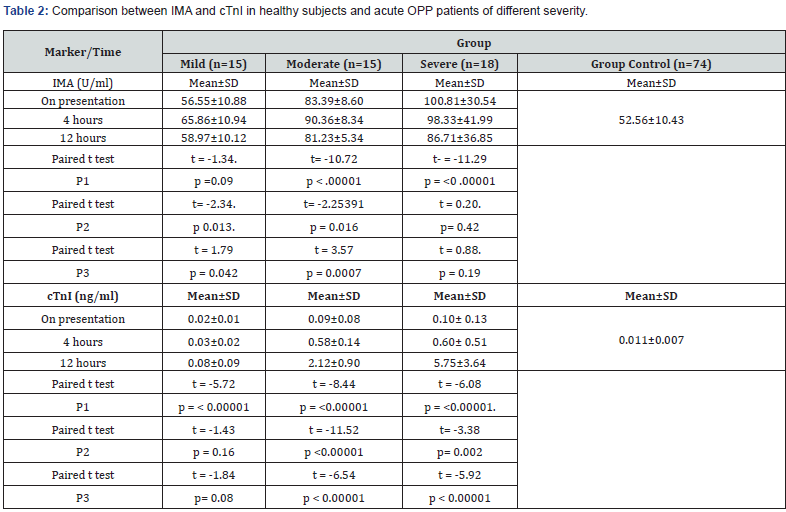
SD: Standard deviation P1: Statistical significance on Presentation versus the control, P2: Statistical significance in on Presentation versus 4 hours in the same group, P3: Statistical Significance in 4 hours versus 12 hours in the same group.

DF: Degree of freedom, SS: Sum of squares; MS: Mean square, F-value: Fisher–Snedecor Distribution, Pr: Probability. Test used: ANOVA test for variance.
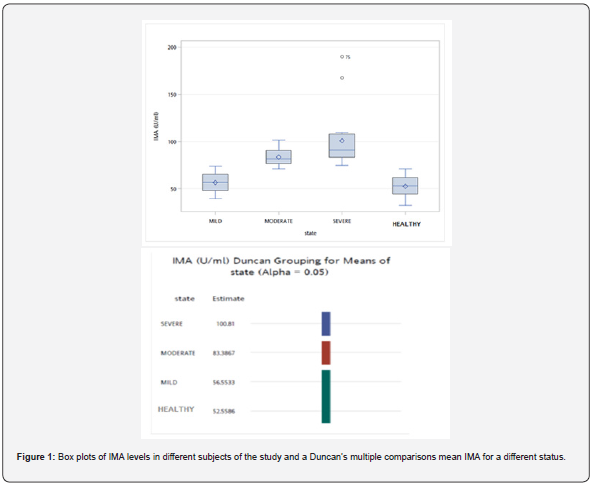
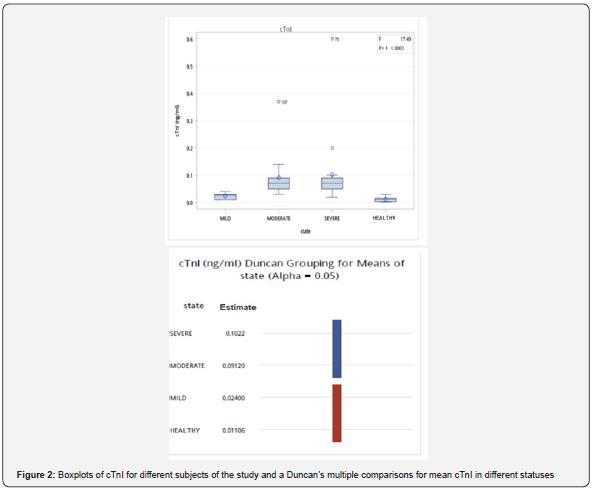
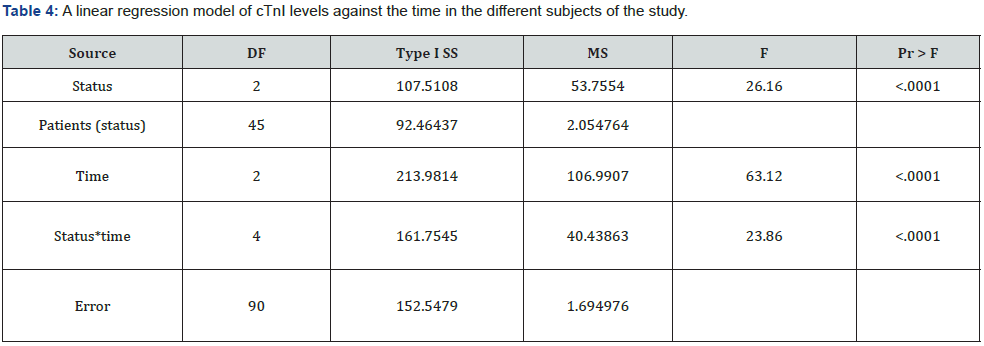
DF; Degree of freedom, SS: Sum of squares; MS: Mean square, F-value: Fisher–Snedecor distribution, Pr: Probability





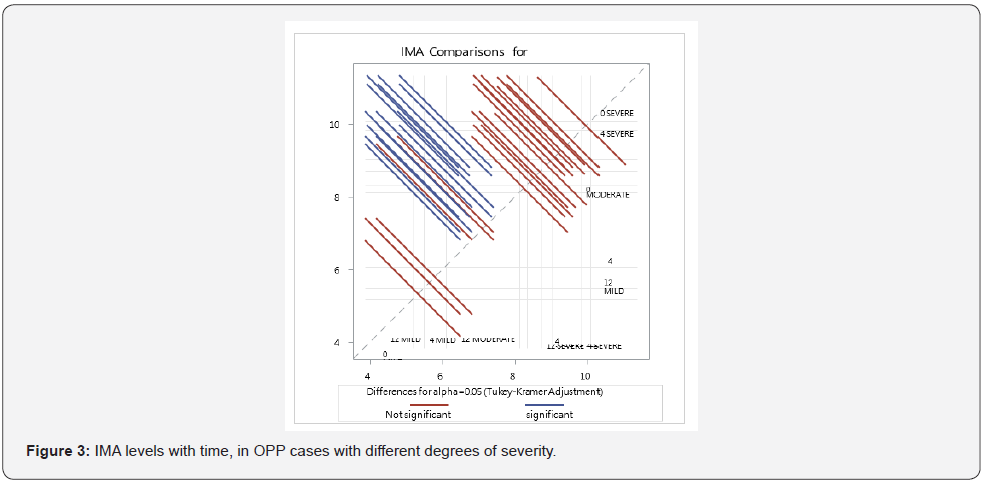
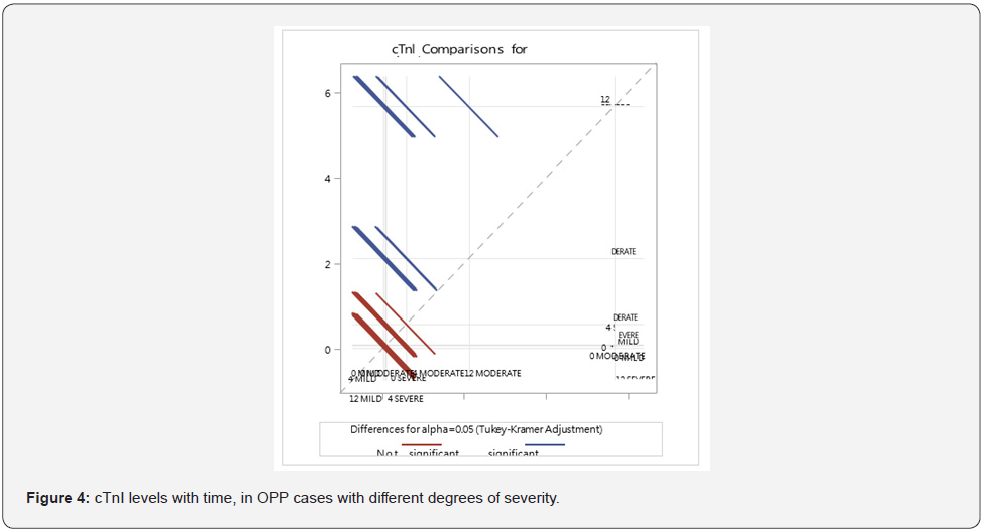
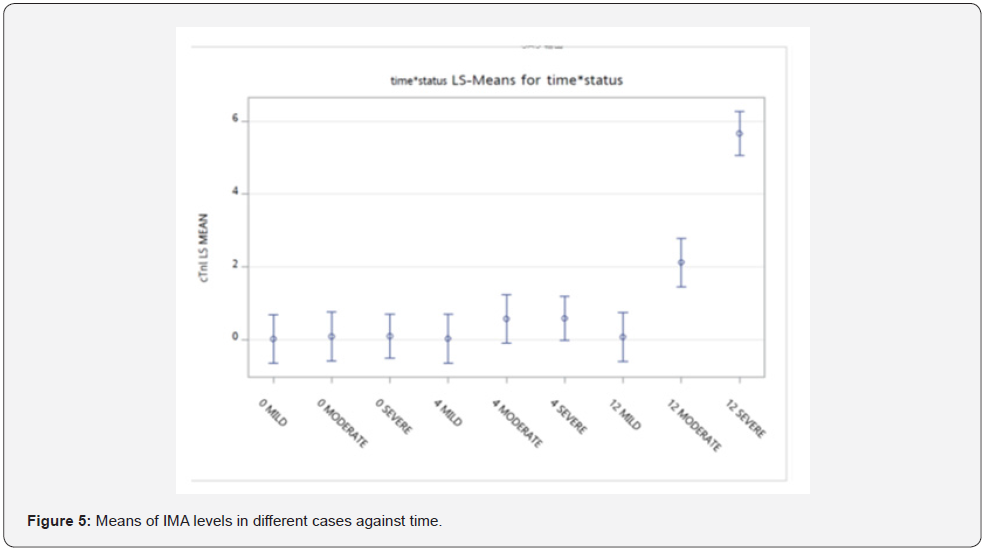
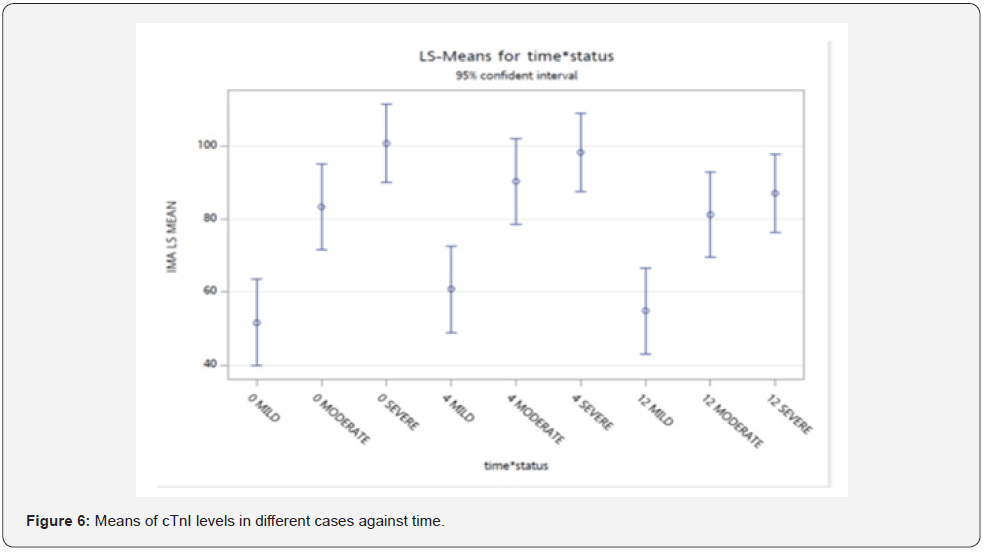
Discussion
Organophosphorus (OP) compounds are widely used for agriculture, domestic pest-control and the chemical warfare. The exposure to OP compounds is very common. Acute organophosphorus poisoning continues to be a detrimental problem and a potential cause of mortality and morbidity worldwide [20]. Cardiac complications are amongst the most common and the most serious complications of OPP. The early detection and the rapid management of cardiac insults in OPP patients is a mainstay for the proper management and improving prognosis of these cases [21]. In this study, IMA was investigated in 48 acute OPP patients, and 74 healthy control subjects, together with the measurement of cTnI enzyme in all of them.
Table 1 represents the studied organophosphorus poisoning cases with different degrees of severity according to their serum cholinesterase levels. There is statistically significant difference between each 2 groups in pattern recognition (P ≤ 0.05) except those marked with red font. The test used is the One-way Anova. P-value is considered significant when ≤ 0.05. The figure 1 shows that severe patients have higher mean IMA than moderate degree patients. Mild degree of OPP patients does not have a statistically different levels of IMA from the studied healthy subjects. The moderate degree OPP patients have higher mean IMA than the mild patients. So, Severe patients have the highest mean IMA than the others. Figure 2 represents boxplots of cTnI levels in different subjects of the study. Duncan’s multiple comparisons shows cTnl for healthy contributors and the cases of OPP of different degrees of severity. Severe cases of OPP are not statistically different from the moderate cases of the study. Mild patients are not statistically different from the healthy subjects of the study. However, moderate cases have a statistically higher mean cTnl than the mild cases. So, severe, and moderate patients (two group patients) have higher mean cTnl than mild patients and healthy people. Table 3 represents a linear regression model of IMA levels against the time in the different subjects of the study. It shows that IMAs are significantly different between patients. Repeated measurement factor (Time) does not have a significant effect on IMA levels. Table 4 represents a linear regression model of cTnI levels against the time in the different subjects of the study. It shows that cTnI levels are significantly different between patients. Repeated measurement factor (Time) had a significant effect on cTnI levels. This is evident also in table 5 and figure 3-6 that show the levels of the measured markers against time in different cases. Images 1-4 show ECG of some cases of the study. It was found that IMA was raised in the OPP cases having impending cardiac ischemia than the healthy control subjects and earlier than the cTnI, and before it is evident in the ECG (Figures 1 & 2). Serum IMA levels were significantly higher in severe cases of cardiac ischemia in OPP than the mild and moderate cases (Table 2). Serum cTnI was also significantly higher in severe cases of cardiac ischemia in OPP than the mild and the moderate cases (Table 2). However, IMA was earlier to rise in these cases than the cTnI enzyme (Table 2). IMA was earlier to rise in cases of suspected cardiac ischemia and the repeated measurement over time did not show a significant effect on IMA levels, unlike cTnI that was raised after some time and showed significant increase at 12 hours in the cases of suspected cardiac ischemia and damage (Tables 3-5 & Figures 3-6). Despite some of the OPP cases showed non-raised cTnI on presentation, while the IMA was raised on presentation, their ECG after some hours, had shown evidence of cardiac ischemia and damage (Images 1-4). This explains what Demir et al. [21] had believed in, which is that IMA is a marker of ischemia, and cTnI is a marker of necrosis. IMA is raised in the period of reversible cellular damage, in the first 4 hours of the insult, while cTnI is raised in the period of irreversible cellular damage, after 4 hours to 24 hours of the insult [21]. IMA is elevated with the oxidative stress after acute ischemia and returns to normal levels in hours after reperfusions. IMA increases wherever the albumin passes through ischemic tissues. This may explain why it was raised rapidly in the cases of suspected ischemia and then declined after hours, while cTnI took hours to rise and then declines after 24 hours of the cardiac ischemia. Moreover, cTnI may not rise during reversible ischemia [1].
Conclusion
OPP is a real risk factor for cardiac ischemia and damage. IMA is a very useful marker as an early indicator of an impending cardiac ischemia. Its main disadvantage is that it is non-specific to cardiac ischemia and can be raised in a wide variety of other pathologic conditions. It can then be used as an early indicator for cardiac ischemia, earlier than cTnI protein, with subsequent monitoring of Troponin I and ECG for an early diagnosis of cardiac ischemia. This helps to discover cardiac ischemia which is a serious complication and is commonly missed to be diagnosed early in OPP patients, thus helping to reduce the morbidity and mortality associated with the OPP.
Declarations
a. Ethics approval and consent to participate: This work was approved from the institutional research board (IRB), and consents from contributors were obtained before they share in the study.
b. Availability of data and materials: Available upon request.
Competing interests: All authors declare that there are no competing interests in the topic, methods, results, or any of the contents of this work.
c. Funding: There was no source of funding for preparation, nor publication of this work.
Acknowledgements
The authors would like to thank the staff of the Poison Unit in the Mansoura Emergency Hospital for the follow up and care during the patients’ management and their help in cases recruitment.
Authors Contributions
a) The first author is the corresponding author has the concept of the article, wrote the proposal, invite the co-authors, worked the practical part, wrote the manuscript, reviewed, and submit for publication.
b) The second author shared in writing the manuscript, explanation of the results, and reviewing before submitting for publication.
c) The third author did the statistical analysis.
d) The fourth author helped in cases and contributor’s recruitment from Mansoura University Hospitals, and in the interpretation of the results.
References
- Chen X, Lin Y, Tian L, Wang Z (2020) Correlation between ischemia-modified albumin level and coronary collateral circulation. BMC Cardiovasc Disord 20: 326.
- Rohlman DS, Davis JW, Ismail A, Abdel Rasoul G, Hendy O, et al. (2020) Risk perception and behavior in Egyptian adolescent pesticide applicators: an intervention study. BMC Public Health 20: 679.
- MaheshwariM, Chaudhary S (2017) Chaudhary S Acute Atrial Fibrillation Complicating Organophosphorus Poisoning. Heart Views 18(3): 96-99.
- Hammarsten O, Mair J, Möckel M, Lindahl B, Jaffe AS (2018) Possible mechanisms behind cardiac troponin elevations. Biomarkers 23(8): 725-734.
- Dhir T, Jiang N (2013) Misleading Elevation of Troponin T caused by Polymyositis. Int J Biomed Sci 9(2): 107-111.
- Park KC, Gaze DC, Collinson PO, Marber MS (2017) Cardiac Troponins: From Myocardial Infarction to Chronic Disease. Cardiovasc Res 113(14): 1708-1718.
- Twerenbold R, Boeddinghaus J, Nestelberger T, Wildi K, Rubini Gimenez M, et al. (2017) Clinical Use of High-Sensitivity Cardiac Troponin in Patients with Suspected Myocardial Infarction. J Am Coll Cardiol 70(8): 996-1012.
- Qin JJ, Cheng X, Zhou F, Lei F, Akolkar G, et al. (2020) Redefining Cardiac Biomarkers in Predicting Mortality of Inpatients with COVID-19. Hypertension 76(4): 1104-1112.
- Shevtsova A, Gordiienko I, Tkachenko V, Galyna Ushakova (2021) Ischemia-Modified Albumin: Origins and Clinical Implications. Dis Markers 9945424.
- Göker AE, Alagöz MH, Güntaş G, Baskadem Yilmazer A, Berkiten G, et al. (2019) Evaluation of serum ischaemia-modified albumin levels in patients with Bell's palsy. J Laryngol Otol (9): 810-813.
- Yarci Gursoy A, Ozdemir ED, Ozdemir H, Candar T, Caglar GS (2017) Ischaemia-modified albumin in preeclampsia: A critical view. J Obstet Gynaecol 37(3): 305-308.
- Sarac F, Yeniocak S, Buyukbese SS, Sahin K, Yucetas E, et al. (2019) The diagnostic value of ischaemia-modified albumin in acute abdominal pain. J Paediatr Child Health 55(10): 1247-1250.
- Du L, Ma J, He D, Zhang X (2019) Serum ischaemia-modified albumin might be a potential biomarker for oxidative stress in amnestic mild cognitive impairment. Psychogeriatrics 19(2): 150-156.
- Aytac Ates H, Yücetaş U, Erkan E, Yucetas E, Ulusoy S, et al. (2019) The Predictive Value of Ischemia-Modified Albumin in Renal Ischemia-Reperfusion Injury. Urol Int 103(4): 473-481.
- Jiao D, Guo F, Yue M, Tian Z (2020) Ischemia-Modified Albumin Is Associated with Arterial Stiffness in Hemodialysis Patients. Int Haert J 61(2): 332-337.
- Motawei SM, Elbiomy AA, Hala S (2017) Sodium bicarbonate and N-acetyl cysteine in treatment of organophosphorus poisoning cases: A randomized controlled clinical trial. Toxicology Open Access 37(6).
- Bar D, Lau E, Winkler JV (2000) A novel assay for cobalt-albumin binding and its potential as a marker for myocardial ischemia-a preliminary report. J Emerg Med 19(4): 311-315.
- B Mishra, S Pandey, SR Niraula, Rai BK, Karki P, et al. (2018) Utility of Ischemia Modified Albumin as an Early Marker for Diagnosis of Acute Coronary Syndrome. J Nepal Health Res Counc 16(1): 16-21.
- Farooqui WA, Uddin M, Qadeer R, Kashif Shafique (2020) Trajectories of vital status parameters and risk of mortality among acute organophosphorus poisoning patients - a latent class growth analysis. BMC Public Health 20(1): 1538.
- Liu XT, Wang L, Chen J, Qi HN, Ma GY (2020) Predictive value of early detection of hs-cTnI and sST2 for secondary cardiac damage in severe acute organophosphorus pesticide poisoning. Zhonghua Lao Dong Wei Sheng Zhi Ye Bing Za Zhi 38(4): 241-245.
- Demir MT, Baydin A, Amanvermez R, Erenler AK, Güzel M, et al. (2018) Comparison of pentraxin-3 and ischemia-modified albumin with troponin in early diagnosis of acute coronary syndrome. Bratisl Lek Listy 119(8): 509-512.






























